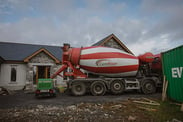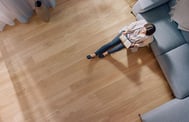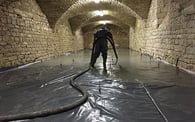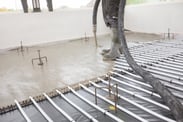Preventing Floor Issues: Understanding Shrinkage and Curling in Screed
Floor screeds may seem simple, but their crucial role in providing a durable foundation for floor finishes cannot be underestimated. However, challenges arise when shrinkage, cracking, and curling occur due to poor installation practices.
When screeds fail to meet the necessary standards, the entire integrity of the floor structure is compromised. This blog will explore the reasons behind such failures and provide insights into preventing these issues. We will also discuss how accredited training programs can equip screed installers with the knowledge needed to ensure long-lasting, flawless floors.
Reasons for Screed Failures
Understanding the reasons behind screed failures is essential for screed installers to deliver high-quality and long-lasting floor installations. Two primary factors that contribute to most screed failures are incorrect manufacture of the screed and incorrect installation practices.
Incorrect Manufacture of the Screed
The manufacturing process plays a critical role in screed performance. An incorrect mix design, where the constituent materials are not used in the correct proportion, can result in weakened screeds.
Additionally, insufficient mixing compromises the integrity and strength of the screed. It's important to note that water, a component of the screed mix, also needs to be used in the correct amount. Adding excessive water may make the material easier to work with, but it weakens the screed and makes it more susceptible to shrinkage, cracking, and curling.
Incorrect Installation of the Screed
Proper installation practices are crucial for screed success. Failure to follow manufacture guidelines can lead to a wide range of issues. For example, not adhering to weatherproofing requirements or the use of unsuitable building conditions can compromise the screed's integrity.
Traditional hand-applied screeds need to be properly compacted after installation. In contrast, liquid applied screeds, such as cement-based liquid screeds, eliminate the need for physical compaction, which reduced the likelihood of a poor screed installation.
By understanding these reasons for screed failures, installers can identify potential pitfalls and take necessary precautions to ensure successful screed installations. Attention to detail during both manufacturing and installation processes can prevent issues such as shrinkage, cracking, and curling, leading to superior, long-lasting floor finishes.
To support this, accredited programs are sometimes offered by manufacturers, giving you the opportunity to learn the best practice installation guidelines for their screed products.
Maintenance and Aftercare Considerations
Proper maintenance and aftercare are vital to prevent potential issues and ensure the longevity of screed installations. By following essential guidelines, screed installers can minimize the risk of failures and maintain the integrity of the floor finish. Here are some key considerations for effective maintenance and aftercare:
Early-Stage Precautions:
- Avoid exposing newly installed screeds to severe drying conditions, such as draughts or direct sunlight. Rapid drying increases the risk of shrinkage and cracking.
- While light foot traffic may be acceptable after 24 to 48 hours, heavy site traffic should be minimized to reduce the risk of physical damage. Exercise caution to protect the screed during this initial period.
- In buildings with underfloor heating (UFH) systems, it is essential to commission the UFH before laying any floor coverings. This step prevents the risk of cracking due to uneven heat distribution.
Late-Stage Considerations:
- Problems that arise after floor finishes are installed or during the building's use primarily affect the floor finish rather than the screed itself. Common issues include unsuitability of the floor surface for the chosen finish and insufficiency of screed drying before floor coverings are applied.
- Ensure thorough checking and testing of both the surface and moisture content before proceeding with floor finishes. Adequate surface preparation is essential to achieve optimal results.
Adhering to maintenance and aftercare guidelines from the day the screed is installed is crucial. By planning and managing the condition of the screed surface and implementing proper care measures, installers can prevent failures, extra labour and safeguard their reputation. Following these practices not only ensures the performance of the screed but also protects the integrity and durability of the entire flooring system.
Strategies for Preventing Screed Failures
To ensure successful screed installations and minimize the risk of failures, screed installers should implement specific strategies and best practices. As mentioned above, becoming an accredited installer for screed products is also a great way to learn best practices for installation and secure your position as an accredited installers, helping you get contracted onto more varied projects.
Below are some key strategies for preventing screed failures:
Become An Approved Screed Installer:
- Expand upon your expertise, developing skills to masterfully install a wide range of liquid screed products.
- Through accredited installer programs access dedicated support from the manufacturer
- Discover the best methods for drying and curing specific ranges of liquid screed products, to avoid issues relating to shrinking and curling in your screeds.
Make Proper Preparations:
- Select the most appropriate screed material for the specific project requirements, considering factors such as drying time, strength, and compatibility with floor finishes.
- Control drying and curing conditions to prevent rapid or uneven drying, which can lead to shrinkage and cracking.
- Install expansion joints where necessary to accommodate any potential movement and reduce the risk of screed failure.
Comply with Aftercare Guidelines:
- Follow recommended aftercare guidelines provided by the manufacturer or supplier of the screed material.
- Commission underfloor heating systems before applying the final floor coverings to minimize the risk of cracking.
- Ensure proper ventilation and avoid excessive moisture accumulation during the drying period.
By implementing these strategies, screed installers can significantly enhance the quality and durability of floor installations. Collaboration with certified professionals, proper preparation, and adherence to aftercare guidelines are crucial steps toward preventing screed failures.
Become A Certified Liquid Screed Installer Today
We understand how hard screed installers work to stay up-to-date with the latest industry best practices. That's why we created the Cemfloor Approved Installer Program, aimed at assisting screed installers in consistently delivering success and quality to their customers through Cemfloor products.
Tailored to your needs, this 1-hour training course focuses on essential guidelines for installing Cemfloor's cement-based liquid screeds and meeting manufacturer standards time and time again.
Cemfloor has built a strong reputation as a trusted manufacturer and provider of screeds, specialising in high-quality cement-based liquid screeds for projects ranging from domestic to commercial sites.
With Cemfloor products and our unwavering commitment to quality, installers can confidently install floors, knowing that the product is always of the highest standard, carrying both UKCA and CE marks.
Join the Cemfloor Screed Installer Program today and become part of a growing community of skilled professionals dedicated to delivering quality-driven projects to their clients.







.png?width=300&height=122&name=Untitled%20design%20(34).png)
